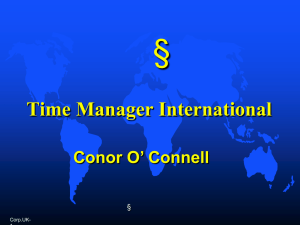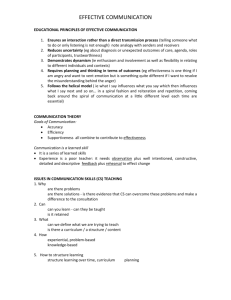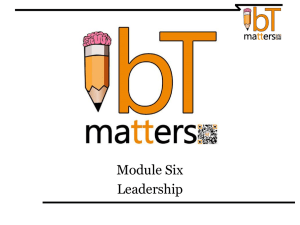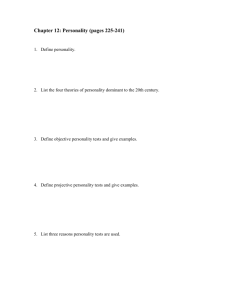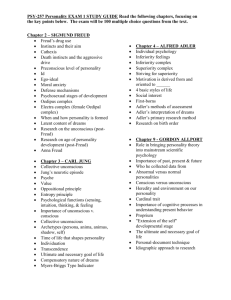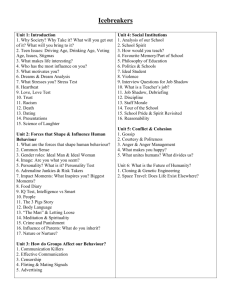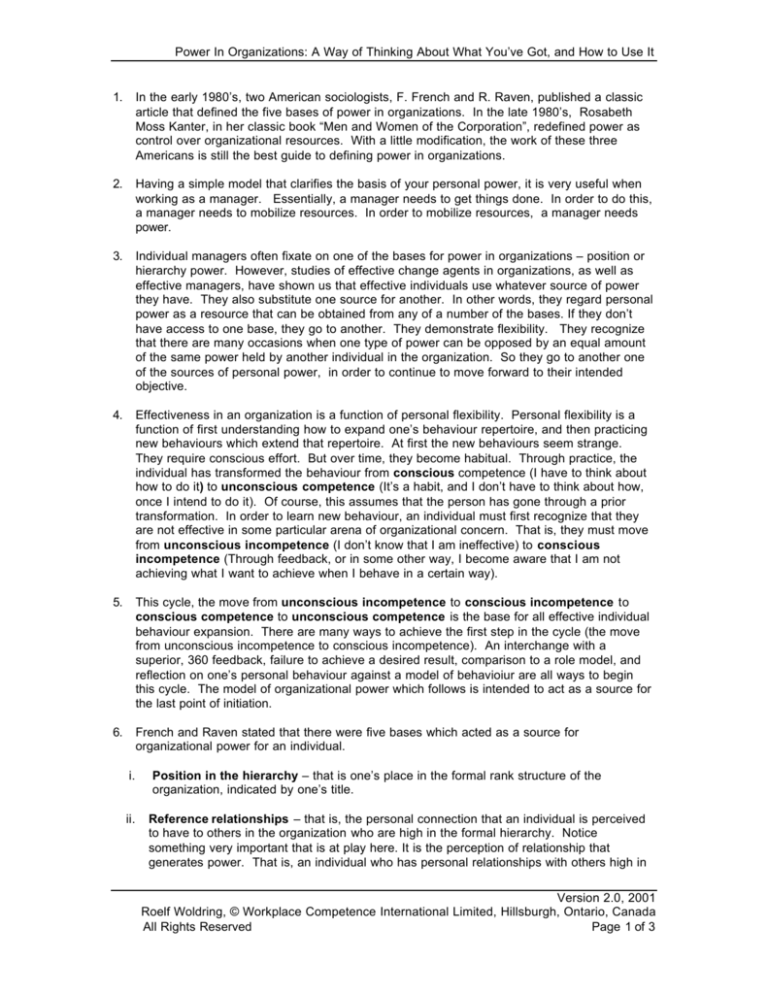
Power In Organizations: A Way of Thinking About What You’ve Got, and How to Use It
1.
In the early 1980’s, two American sociologists, F. French and R. Raven, published a classic
article that defined the five bases of power in organizations. In the late 1980’s, Rosabeth
Moss Kanter, in her classic book “Men and Women of the Corporation”, redefined power as
control over organizational resources. With a little modification, the work of these three
Americans is still the best guide to defining power in organizations.
2.
Having a simple model that clarifies the basis of your personal power, it is very useful when
working as a manager. Essentially, a manager needs to get things done. In order to do this,
a manager needs to mobilize resources. In order to mobilize resources, a manager needs
power.
3.
Individual managers often fixate on one of the bases for power in organizations – position or
hierarchy power. However, studies of effective change agents in organizations, as well as
effective managers, have shown us that effective individuals use whatever source of power
they have. They also substitute one source for another. In other words, they regard personal
power as a resource that can be obtained from any of a number of the bases. If they don’t
have access to one base, they go to another. They demonstrate flexibility. They recognize
that there are many occasions when one type of power can be opposed by an equal amount
of the same power held by another individual in the organization. So they go to another one
of the sources of personal power, in order to continue to move forward to their intended
objective.
4.
Effectiveness in an organization is a function of personal flexibility. Personal flexibility is a
function of first understanding how to expand one’s behaviour repertoire, and then practicing
new behaviours which extend that repertoire. At first the new behaviours seem strange.
They require conscious effort. But over time, they become habitual. Through practice, the
individual has transformed the behaviour from conscious competence (I have to think about
how to do it) to unconscious competence (It’s a habit, and I don’t have to think about how,
once I intend to do it). Of course, this assumes that the person has gone through a prior
transformation. In order to learn new behaviour, an individual must first recognize that they
are not effective in some particular arena of organizational concern. That is, they must move
from unconscious incompetence (I don’t know that I am ineffective) to conscious
incompetence (Through feedback, or in some other way, I become aware that I am not
achieving what I want to achieve when I behave in a certain way).
5.
This cycle, the move from unconscious incompetence to conscious incompetence to
conscious competence to unconscious competence is the base for all effective individual
behaviour expansion. There are many ways to achieve the first step in the cycle (the move
from unconscious incompetence to conscious incompetence). An interchange with a
superior, 360 feedback, failure to achieve a desired result, comparison to a role model, and
reflection on one’s personal behaviour against a model of behavioiur are all ways to begin
this cycle. The model of organizational power which follows is intended to act as a source for
the last point of initiation.
6.
French and Raven stated that there were five bases which acted as a source for
organizational power for an individual.
i.
ii.
Position in the hierarchy – that is one’s place in the formal rank structure of the
organization, indicated by one’s title.
Reference relationships – that is, the personal connection that an individual is perceived
to have to others in the organization who are high in the formal hierarchy. Notice
something very important that is at play here. It is the perception of relationship that
generates power. That is, an individual who has personal relationships with others high in
Version 2.0, 2001
Roelf Woldring, © Workplace Competence International Limited, Hillsburgh, Ontario, Canada
All Rights Reserved
Page 1 of 3
Power In Organizations: A Way of Thinking About What You’ve Got, and How to Use It
the hierarchy, but whose relationships are not obvious to others does not have access to
this source of power. It is only when the individual can credibly reference the existence of
these relationships that they act as a source of personal power.
iii.
Resource control acts in interesting kinds of ways. Because of the bureaucratic nature of
many organizations, individuals relatively low in the formal hierarchy can often have a great
deal of resource control. The classic example is the facilities manager who can override
the requirements of a VP for the design of a personal office, because that facilities
manager has been empowered by the organization to enforce a facilities policy. Another
example is the IT service analyst who can override the decision of a manager to have a
particular kind or configuration of a personal computer, because of standards created as
part of an overall technology policy. Literally then, resource control means the ability to
mobilize or deny the mobilization of organizational resources: dollars, people, assets, and
external relationships.
iv.
Demonstrated expertise – An individual who is recognized as having the capability, and
special knowledge, in an area of importance to others in the organization has expert
power. Once again, passively having the expertise is not enough. The individual must
behave in a way which leads others in the organization who have personal power to
recognize and value the expertise.
v.
Personality power – the way a person expresses personality (how I behave, dress, and
communicate) in an organization can grant them power. It’s been long recognized that
senior executives who use their emotions in explicit ways to create drama, define stands
on issues, communicate to large groups, provide leadership to task and problem solving
teams, engage in and win battles around issues with organizational peers, and represent
the organization visibly in the exterior world, all have personal power. These are all forms
of expression of one’s personality. They represent who one is, and how one wants to be in
the world.
7.
Since the French and Raven article, it has become clear that information power needs to be
added to these five. At one time, information was considered just another form of resource.
Access to information was considered a form of expertise. But with the growing use of
information technology, and the growing dependency of organizations on information in order
to compete effectively in the exterior marketplace, information power has become a source of
personal power in its own right. In fact, confrontation through the presentation of relevant
and well-organized facts is often a more effective way of political maneuvering within an
organization than interpersonal conflict that is resolved through the use of personality. It is
not just access to information that defines this source of personal power. Rather, it is the
combination of access and effective presentation. Presentation is a function of timing,
format, media and content organization.
8.
Whenever an individual in an organization starts out to accomplish something, an informal
power audit is a very effective way to shape the required action planning. By assessing
where your personal power comes from, and comparing it to the needs of your objective, you
are beginning to treat power as a resource over which you have a degree of control. Rather
than accepting that ability to mobilize resources is limited by your position in the hierarchy,
you will begin to see your formal rank as just one of the sources of the power and energy you
need to accomplish your results.
9.
Information expertise and resource power can be built up relatively quickly compared to the
other three. Particularly in a project organization, access to these sources of power is often
granted to individuals as part of a project scoping and initial approval exercise. Once they
Version 2.0, 2001
Roelf Woldring, © Workplace Competence International Limited, Hillsburgh, Ontario, Canada
All Rights Reserved
Page 2 of 3
Power In Organizations: A Way of Thinking About What You’ve Got, and How to Use It
give you initial access to resources, you can use them to extend your access to additional
sources of power:
•
Expertise - both your own and that of others on your project staff;
•
Resource control - through negotiation of access to resources in the organization which
are necessary to complete the approved project;
•
Information - through the marshalling of facts and their presentation at steering
committees and other meetings necessitated by the project plan.
As well, you can use the projected impact of the project to initiate and grow relationships with
individuals in the organization who have visible power (reference power).
10. Position power and personality power are the hardest to grow in the short term.
•
Position power requires moves in the formal hierarchy of the organization. This usually
does not happen at intervals shorter than every few years.
•
Personality power is a complex function of the nature with which you were born and the
development that you have received through the nurturing over the course of your
lifetime. However, solid interpersonal skill training can do a great deal to broaden the
range with which you express your personality. Invest in good presentation skills training
(the courses which use formal video based feedback). Leadership development
programs, especially the ones which use broad based 360 type feedback or intensive
personal development experiences, can help expand the ways in which you express your
personality in an organization. – Investigate the Niagara Institute in Canada or National
Training Laboratories in the United States (both of which have web sites). You will
discover that it is often more a question of how you choose to express the personality
that you have rather than change its fundamentals.
Version 2.0, 2001
Roelf Woldring, © Workplace Competence International Limited, Hillsburgh, Ontario, Canada
All Rights Reserved
Page 3 of 3

